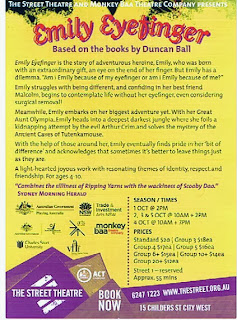 |
| Program cover image: 'Kiss'. Photo: Simon Turtle |
Brief Encounter by Noël Coward, adapted
and directed by Emma Rice. Kneehigh Theatre Company (UK) at Canberra
Theatre Centre, October 2-5, 2013.
Reviewed by
Frank McKone
October 2
When Noël Coward rewrote his 1936 stage play
Still Life in 1945 as the script for the film
Brief Encounter, I was just 4. I had seen
Bambi and
Dumbo the Elephant, but missed
Brief Encounter – and remained largely unaware of the film ever since.
Growing up in the 1950s, I became very aware of Noël Coward, but only for his songs, particularly
Mad Dogs and Englishmen (for its anti-colonial political content) and
Don’t Let Your Daughter on the Stage, Mrs Worthington which informed my drama work for the rest of my life.
Now, suddenly, in my maturity, I have been given a new appreciation of Coward, the playwright, by two productions:
Private Lives at Belvoir (Canberra Critics’ Circle Tuesday, October 2, 2012) and now
Brief Encounter by Kneehigh.
After
the Cockney-style bit of song and dance to entertain us while settling
in our seats, the beginning of the actual play reminded me of Woody
Allen’s
The Purple Rose of Cairo (1985). Without knowing the script of
Brief Encounter
beforehand I was not expecting to be treated as if I were in a cinema
(the Palladium), with the two central characters Laura Jesson (Michelle
Nightingale) and Alec Harvey (Jim Sturgeon) in our front row spotlit by
the ushers’ torches as they seem to have a lovers’ tiff about whether
they love each other.
(I digress slightly to point out
that the Palladium Cinema was closed on 3rd April 1938, so even this
1945 script had to look back to its 1936 original to make a Coward
in-joke about the Palladium Cinema being too expensive upstairs – a
comparison with the famous Palladium Theatre, which is still extant
today and is probably too expensive downstairs.)
The
connection with Woody Allen’s film is that as Laura leaves the cinema,
she walks up on to the stage towards a scrim on which is projected her
husband Fred (Joe Alessi) waiting for her at home. She parts the scrim,
and simultaneously appears in the movie with Fred, while Alec watches.
The theatrical trick immediately gained the audience’s applause, and
our interest in these characters’ story was engaged.
The
style of this production was now firmly established: movement became
dance, dialogue was timed to the music, and songs were an essential part
of the action. Ordinary ideas of reality were tested at every turn,
from Laura’s children being puppets, a toy train puffing out real smoke,
crashing seas on the film screen seeming to drown characters in emotion
on stage, even a whole express train passing through on film projected
on a scrim rushed across the stage by a railway guard – in fact so many
such devices that I would need to see the production several times to
catch up with all the fascinating details.
And it’s
certainly a production that deserves to be seen more than once. I’m
sure it would be more enjoyable each time. On the first sighting each
trick was a surprise, but on subsequent viewing it would be the
anticipation and recognition, and the testing of your memory that would
be exciting. And indeed, like watching a circus, there would be the
adrenalin rush of fearing that a trick might fail, especially when you
know that this production has been touring for some five years now.
The
real surprise of this kind of choreographed staging was that the
feelings of the two middle-class protagonists – each married and having
to deal with their sense of guilt and propriety – were enhanced,
especially through the comic contrasts of the lower class characters’
relationships. Almost Shakespearean, in fact, and demanding of the
performers the same kind of precision of characterisation and timing.
Not a beat was missed by anyone.
So I began wondering
what had Emma Rice done to Noël Coward’s original conception. Was this a
modernisation, even though everything we saw was “retro”, as in 1936?
But then how did references get in like the two soldiers, full – to the
point of being threatening – with their sense of self-importance because
they were “willing to lay down our lives for you”; or mention of
Spitfires, or Judy Garland? Was the staging and style, though very
different from Belvoir’s
Private Lives, a kind of updating of Coward’s work?
The Kindle came to the rescue, almost instantly downloading the Bloomsbury Methuen Drama publication of
Brief Encounter
and, wonder of wonders, there were Coward’s original words, laid out
ready for filling in all the spaces in the dialogue with so much more
than the minimal directions Coward supplied for the film. The effect
for me was both eminently theatrical, and effective in showing the
skill, and the humanity, of Coward as a writer and a step up from where I
had previously thought of him.
Not everyone agrees with me – see Murray Bramwell’s review in The Australian, September 16, 2013 at
http://www.theaustralian.com.au/arts/cowards-ironies-lost-in-the-action/story-e6frg8n6-1226719542652 for a different view, but perhaps more influenced by knowing the
Brief Encounter history beyond
Bambi and
Dumbo.
© Frank McKone, Canberra















